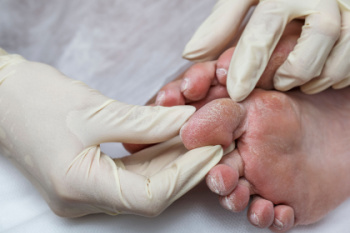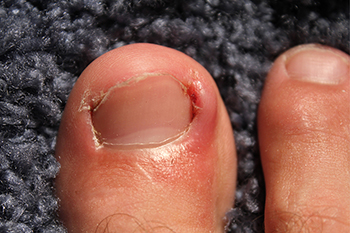Blog
Items filtered by date: May 2025
Understanding Achilles Tendinopathy

Achilles tendinopathy is a condition that affects the tendon at the back of the ankle, which connects the calf muscles to the heel bone. It usually develops over time from repeated stress, such as running, jumping, or even walking long distances. The tendon may become thick, swollen, and painful, especially during or after activity. The discomfort often starts gradually and can worsen, if left untreated. Contributing factors include tight calf muscles, poor foot mechanics, or unsupportive footwear. Treatment may include rest, stretching exercises, and wearing supportive shoes or orthotics. In some cases, targeted exercise is recommended to help strengthen the tendon and improve flexibility. Continuing to use the tendon without allowing it to heal may lead to more serious injury. If you have pain or stiffness in the back of your heel that is not improving, it is suggested that you visit a podiatrist for a full evaluation and personalized care plan.
Achilles tendon injuries need immediate attention to avoid future complications. If you have any concerns, contact Stephanie Tine, DPM of Flamingo Foot and Ankle. Our doctor can provide the care you need to keep you pain-free and on your feet.
What Is the Achilles Tendon?
The Achilles tendon is a tendon that connects the lower leg muscles and calf to the heel of the foot. It is the strongest tendon in the human body and is essential for making movement possible. Because this tendon is such an integral part of the body, any injuries to it can create immense difficulties and should immediately be presented to a doctor.
What Are the Symptoms of an Achilles Tendon Injury?
There are various types of injuries that can affect the Achilles tendon. The two most common injuries are Achilles tendinitis and ruptures of the tendon.
Achilles Tendinitis Symptoms
- Inflammation
- Dull to severe pain
- Increased blood flow to the tendon
- Thickening of the tendon
Rupture Symptoms
- Extreme pain and swelling in the foot
- Total immobility
Treatment and Prevention
Achilles tendon injuries are diagnosed by a thorough physical evaluation, which can include an MRI. Treatment involves rest, physical therapy, and in some cases, surgery. However, various preventative measures can be taken to avoid these injuries, such as:
- Thorough stretching of the tendon before and after exercise
- Strengthening exercises like calf raises, squats, leg curls, leg extensions, leg raises, lunges, and leg presses
If you have any questions please feel free to contact our office located in Fort Lauderdale, FL . We offer the newest diagnostic tools and technology to treat your foot and ankle needs.
Are You Suffering From Nerve Damage?
Managing Diabetic Foot Infections

Diabetic foot infections can become serious very quickly, especially when there is an open sore or ulcer on the foot. Because people with diabetes often have reduced feeling in their feet, small injuries can go unnoticed and easily become infected. A podiatrist can check for signs such as redness, swelling, warmth, or drainage from a wound. Diabetic foot infections may be mild or severe and sometimes spread to deeper tissues, including muscle or bone. If an infection is suspected, the podiatrist may clean the wound and take a small sample for testing. X-rays or other scans may also be needed to see if the bone is involved. Treatment often includes antibiotics, and, in more serious cases, surgery to remove damaged tissue. Managing blood sugar levels is important because high blood sugar can make it harder for the body to heal. If you have developed a diabetic foot infection, it is suggested that you make an immediate appointment with a podiatrist for appropriate treatment.
Diabetic foot care is important in preventing foot ailments such as ulcers. If you are suffering from diabetes or have any other concerns about your feet, contact Stephanie Tine, DPM from Flamingo Foot and Ankle. Our doctor can provide the care you need to keep you pain-free and on your feet.
Diabetic Foot Care
Diabetes affects millions of people every year. The condition can damage blood vessels in many parts of the body, especially the feet. Because of this, taking care of your feet is essential if you have diabetes, and having a podiatrist help monitor your foot health is highly recommended.
The Importance of Caring for Your Feet
- Routinely inspect your feet for bruises or sores.
- Wear socks that fit your feet comfortably.
- Wear comfortable shoes that provide adequate support.
Patients with diabetes should have their doctor monitor their blood levels, as blood sugar levels play such a huge role in diabetic care. Monitoring these levels on a regular basis is highly advised.
It is always best to inform your healthcare professional of any concerns you may have regarding your feet, especially for diabetic patients. Early treatment and routine foot examinations are keys to maintaining proper health, especially because severe complications can arise if proper treatment is not applied.
If you have any questions please feel free to contact our office located in Fort Lauderdale, FL . We offer the newest diagnostic and treatment technologies for all your foot and ankle needs.
How to Treat an Ingrown Toenail

Ingrown toenails happen when the edge of the nail grows into the surrounding skin. This can cause pain, redness, swelling and sometimes infection. Soaking the foot in warm water can help soften the area and reduce discomfort. Gently lifting the nail with a small piece of cotton or dental floss may guide it to grow above the skin. Wearing open-toed or roomy shoes can also ease pressure on the toe. However, trying to cut the nail yourself can make things worse. If home care does not help or the area becomes infected, a podiatrist can safely remove part of the nail. In some cases, a small procedure is done to keep the nail from growing back into the skin. If you have a painful toenail that does not improve, it is suggested you see a podiatrist for diagnosis and appropriate treatment.
Ingrown toenails may initially present themselves as a minor discomfort, but they may progress into an infection in the skin without proper treatment. For more information about ingrown toenails, contact Stephanie Tine, DPM of Flamingo Foot and Ankle. Our doctor can provide the care you need to keep you pain-free and on your feet.
Ingrown Toenails
Ingrown toenails are caused when the corner or side of a toenail grows into the soft flesh surrounding it. They often result in redness, swelling, pain, and in some cases, infection. This condition typically affects the big toe and may recur if it is not treated properly.
Causes
- Improper toenail trimming
- Genetics
- Improper shoe fitting
- Injury from pedicures or nail picking
- Abnormal gait
- Poor hygiene
You are more likely to develop an ingrown toenail if you are obese, have diabetes, arthritis, or have any fungal infection in your nails. Additionally, people who have foot or toe deformities are at a higher risk of developing an ingrown toenail.
Symptoms
Some symptoms of ingrown toenails are redness, swelling, and pain. In rare cases, there may be a yellowish drainage coming from the nail.
Treatment
Ignoring an ingrown toenail can have serious complications. Infections of the nail border can progress to a deeper soft-tissue infection, which can then turn into a bone infection. You should always speak with your podiatrist if you suspect you have an ingrown toenail, especially if you have diabetes or poor circulation.
If you have any questions, please feel free to contact our office located in Fort Lauderdale, FL . We offer the newest diagnostic and treatment technologies for all your foot care needs.
Why Foot Wounds May Not Heal

Foot wounds that do not heal properly are often a sign of underlying health issues that require medical attention. Poor circulation, commonly seen in conditions like diabetes or peripheral artery disease, can limit the flow of oxygen and nutrients necessary for healing. Infections can also delay recovery by causing ongoing inflammation and tissue damage. Other factors, such as repeated pressure, wearing improper footwear, or unrecognized trauma, can keep wounds from closing. Symptoms that indicate a wound is not healing include persistent redness, swelling, drainage, foul odor, or increasing pain. The appearance of black or dead tissue around the wound edges is another serious warning sign. If you have developed a foot wound that is not healing as it should, it is strongly suggested that you promptly contact a podiatrist who can diagnose the cause, and effectively treat cuts and wounds on the feet.
Wound care is an important part in dealing with diabetes. If you have diabetes and a foot wound or would like more information about wound care for diabetics, consult with Stephanie Tine, DPM from Flamingo Foot and Ankle. Our doctor will assess your condition and provide you with quality foot and ankle treatment.
What Is Wound Care?
Wound care is the practice of taking proper care of a wound. This can range from the smallest to the largest of wounds. While everyone can benefit from proper wound care, it is much more important for diabetics. Diabetics often suffer from poor blood circulation which causes wounds to heal much slower than they would in a non-diabetic.
What Is the Importance of Wound Care?
While it may not seem apparent with small ulcers on the foot, for diabetics, any size ulcer can become infected. Diabetics often also suffer from neuropathy, or nerve loss. This means they might not even feel when they have an ulcer on their foot. If the wound becomes severely infected, amputation may be necessary. Therefore, it is of the upmost importance to properly care for any and all foot wounds.
How to Care for Wounds
The best way to care for foot wounds is to prevent them. For diabetics, this means daily inspections of the feet for any signs of abnormalities or ulcers. It is also recommended to see a podiatrist several times a year for a foot inspection. If you do have an ulcer, run the wound under water to clear dirt from the wound; then apply antibiotic ointment to the wound and cover with a bandage. Bandages should be changed daily and keeping pressure off the wound is smart. It is advised to see a podiatrist, who can keep an eye on it.
If you have any questions, please feel free to contact our office located in Fort Lauderdale, FL . We offer the newest diagnostic and treatment technologies for all your foot care needs.
Blog Archives
- August 2025
- July 2025
- June 2025
- May 2025
- April 2025
- March 2025
- February 2025
- January 2025
- December 2024
- November 2024
- October 2024
- September 2024
- August 2024
- July 2024
- June 2024
- May 2024
- April 2024
- March 2024
- February 2024
- January 2024
- December 2023
- November 2023
- October 2023
- September 2023
- August 2023
- July 2023
- June 2023
- May 2023
- April 2023
- March 2023
- February 2023
- January 2023
- December 2022
- November 2022
